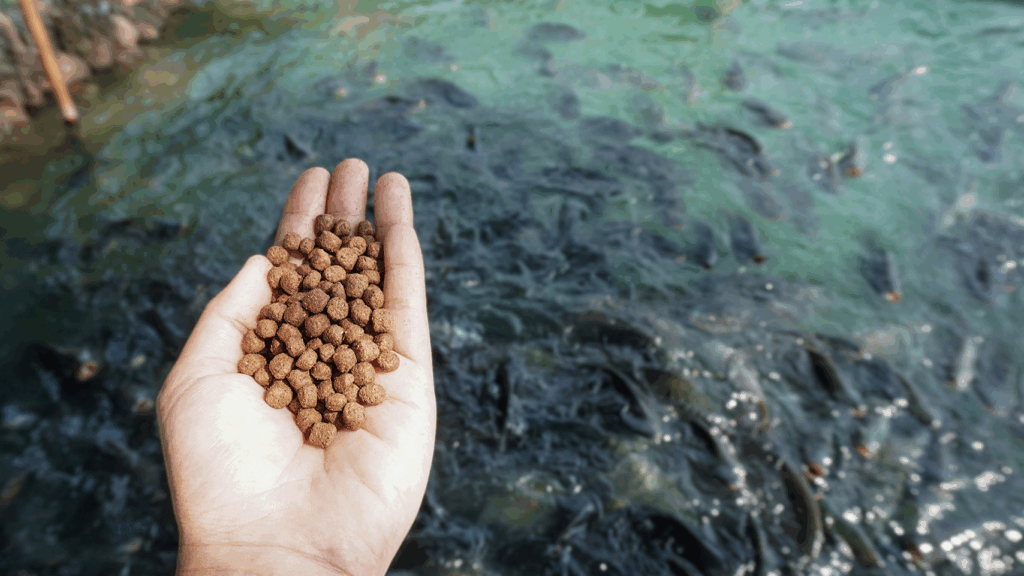Aquaculture feeds the world—but what feeds aquaculture?
The demand for fish is steadily rising worldwide, while pressure on wild-caught fisheries continues to grow. Farmed seafood is stepping up to meet this need. But the success of aquaculture hinges on one essential factor: feed. Currently, most aquafeeds rely on fishmeal and soy—two ingredients with significant environmental and supply chain drawbacks.
Now, a new protein source is gaining traction. Black Soldier Fly (BSF) larvae are emerging as a viable, sustainable, and circular ingredient in modern fish diets. Rich in protein and nutrients, they offer a promising way forward. But are they ready to scale?
The Challenge with Traditional Feeds
Fishmeal and soy dominate aquafeed formulas, but they come at a cost. Fishmeal, harvested from species like anchovy and sardine, contributes to overfishing and destabilises marine ecosystems. Soy production, meanwhile, demands large-scale agriculture with significant land, water, and fertiliser use—often linked to deforestation.
With aquaculture projected to supply over 60% of global fish consumption by 2030, the current approach is hard to sustain. The industry needs protein sources that are nutritionally effective, environmentally responsible, and more resilient to global supply shocks.

Why Insects Make Sense
Insects aren’t a novelty in aquaculture diets—they’re a natural part of what many finfish and crustaceans would consume in the wild. This evolutionary alignment makes them a biologically relevant candidate for fish nutrition.
Among the alternatives, Black Soldier Fly larvae (BSFL) stand out for both their biological compatibility and production model. They’re raised on organic waste streams and converted into a nutrient-rich meal. This meal offers digestible protein, essential amino acids, and beneficial fats that support healthy growth.
BSFL’s nutrient profile aligns well with the natural dietary preferences of farmed fish. It’s not just about nutritional content—these larvae mirror what fish would naturally encounter in the wild, making them an intuitive fit for aquafeed.
Performance in Practice
BSFL-based feed has been trialled across species including tilapia, trout, salmon, carp, catfish, and shrimp. In many cases, BSFL replacement of fishmeal has led to equal or improved feed conversion, weight gain, and overall health.
Feeding trials reinforce this. In Nile tilapia, a 12-week study tested fishmeal replacement levels from 10% to 100%. The findings were clear: no adverse impact on growth or survival, and the best outcomes at 47% replacement (Tippayadara et al., 2021). At this rate, fish showed strong growth, efficient feed conversion, and elevated lysozyme activity—a marker of immune health.
Tilapia, being omnivorous, may be particularly well-suited to BSFL diets due to their ability to digest chitin—a compound found in insect exoskeletons that can also act as a prebiotic and immune stimulator. This digestive trait gives species like tilapia a distinct advantage when transitioning to insect-based feeds.
This data not only validates BSFL’s suitability for aquafeed but also gives feed formulators a practical benchmark. By targeting species-specific tolerance levels like the 47% mark for tilapia, producers can make more informed, cost-effective inclusion decisions.
Better for the Environment Too
Black Soldier Fly Larvae meal production is resource-efficient. Compared to fishmeal or soy, it requires significantly less land and water. Lifecycle assessments report a 50–95% reduction in greenhouse gas emissions relative to traditional proteins (Smetana et al., 2016).
The production process also turns organic waste into valuable protein. BSFL thrive on food scraps, spent grains, and agricultural byproducts. This diverts waste from landfills and cuts methane emissions.
Importantly, Black Soldier Fly farming systems are versatile. They can operate in rural, urban, or peri-urban environments, enabling regional feed production that reduces transport costs and supports local economies.
Ready to Scale
As insect farming technology matures, Black Soldier Fly Larvae meal is approaching cost parity with premium fishmeal. Production costs now range from $1.50 to $2.50 per kilogram depending on scale and location (Gold et al., 2020).
The value proposition goes beyond protein. BSF farms also yield frass (used as organic fertiliser) and BSF oil with commercial potential. These byproducts create multiple revenue streams and support financial viability.
Vertical systems, automation, and co-location with food processors are helping reduce costs and optimise logistics—bringing BSFL closer to wide-scale adoption.
Policy Shifts and Momentum
Policy support is catching up to the science. The EU and UK allow Black Soldier Fly Larvae meal in aquafeed and are expanding approvals to other livestock sectors. In the US, salmonid diets can now include BSFL under FDA and AAFCO guidelines.
Feed giants are already active. Skretting launched a salmon feed with BSFL as early as 2018 (Skretting, 2018). Cargill and BioMar are trialling insect-based formulations and forming strategic partnerships. Retailers are beginning to highlight insect-fed fish on labels—a signal that consumer demand is also evolving.
The Path Forward
To secure Black Soldier Fly Larvae’s place in mainstream aquafeed, a few things must come together:
- Reliable inputs: A steady stream of clean, organic waste is essential for consistent BSFL production.
- Farmer guidance: Aquaculture producers need clear direction on feed formulation and species-specific benefits.
- Supportive policy: Transparent, science-led regulations will be critical for scaling across regions and markets.
All of these are now progressing, setting the stage for BSFL meal to play a bigger role in global feed strategies.
Black Soldier Fly meal isn’t just a novel ingredient—it’s a practical response to the challenges facing modern aquafeed. From reducing pressure on overfished stocks to turning waste into protein, BSFL meal offers real benefits for producers, the environment, and fish alike.
With credible data behind its performance, growing regulatory support, and increasing commercial uptake, the groundwork is in place. What’s needed now is continued collaboration across sectors to refine feed strategies, scale production, and keep building the case for insect-based nutrition in aquaculture.
As farmed fish continue to feed a growing global population, it’s clear that the future of aquafeed will be shaped not just by what we catch or grow—but by what we raise from waste.
